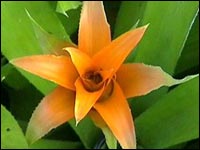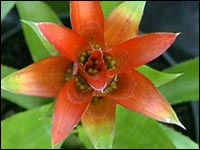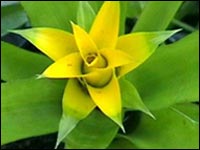Winter colour — Canistropsis billbergioidesWondering how to inject a bit of colour into your dreary, winter garden? Well we have a colourful solution. The eye-catching plants are small to medium sized and grow to about one foot to 18 inches tall. They are identifiable by their large green leaves, showcasing a central, clustered head of colour in showy oranges, pinks or reds. They do best in shady areas so it pays to plant them under trees, or in areas that don't receive a lot of afternoon sun. Among our favourites are the 'Citron', 'Persimmon' and 'Tutti Frutti'. The Citron, a bright yellow variety as its name would suggest, is smaller than most varieties. Flowering from May to September, it bears shiny green leaves that are slightly lighter and softer than others. The Citron is perfect as a pot plant. The Persimmon features an unusual star shaped flower with a striking burnt orange colour with slight tinges of green. It flowers a little earlier than other varieties — sometimes flowering as early as March. The Tutti Frutti has larger leaves and features one of the more stunning flowers. The dramatic burnt orange flower changes to a deep mulberry read as it ages. For more information go to www.bromeliads.co.nz
|
Home | Journal
| Newsletter | Conferences
Awards | Join
RNZIH | RNZIH Directory | Links
© 2000–2024 Royal New Zealand Institute of Horticulture
Last updated: June 2, 2004


 Member of
the bromeliad family, the Canistropsis billbergioides come
in a number of colourful varieties, which mainly flower from May
to September.
Member of
the bromeliad family, the Canistropsis billbergioides come
in a number of colourful varieties, which mainly flower from May
to September. If you are
planting them during winter take note that they get the shade they
need so that come summer they are not scorched by the sun.
If you are
planting them during winter take note that they get the shade they
need so that come summer they are not scorched by the sun. It remains in
colour for up to three months. Again, it is ideal for pot plants,
but if outdoors it is best under dense trees, where its flowers
appear to shine from the shade.
It remains in
colour for up to three months. Again, it is ideal for pot plants,
but if outdoors it is best under dense trees, where its flowers
appear to shine from the shade.